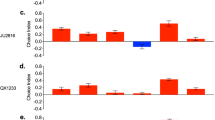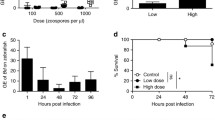Abstract
Batrachochytrium dendrobatidis (Bd) has been identified as a causative agent in the precipitous decline of amphibians worldwide. Studies on the fungus including its ability to infect and kill the host require use of frogs, a precious resource. Therefore, the development of an alternate host model to study the virulence of the fungus would be useful. Here, we show that Bd can cause mortality in the nematode Caenorhabditis elegans. Incubation of Bd with C. elegans resulted in greater than 70% mortality in the nematodes over a period of 24 h. Fluorescence microscopy using propidium iodide, a fluorescent dye used to determine cell viability, and tactile assays were used to discriminate between live and dead nematodes. These observations suggest that C. elegans may be a useful model organism to study the pathogenicity and virulence mechanisms of Bd.



Similar content being viewed by others
References
Berger L, Speare R, Daszak P, Green DE, Cunningham AA, Goggin CL, Slocombe R, Ragan MA, Hyatt AD, McDonald KR, Hines HB, Lips KR, Marantelli G, Parkes H. Chytridiomycosis causes amphibian mortality associated with population declines in the rain forests of Australia and Central America. Proc Natl Acad Sci USA. 1998;95:9031–6.
Daszak P, Berger L, Cunningham AA, Hyatt AD, Greene DE, Speare R. Emerging infectious diseases and amphibian population declines. Emerg Infect Dis. 1999;5:735–48.
Longcore JE, Pessier AP, Nichols DK. Batrachochytrium dendrobatidis gen et sp nov, a chytrid pathogenic to amphibians. Mycologia. 1999;91:219–27.
Stuart SN, Chanson JS, Cox NA, Young BE, Rodrigues ASL, Fischman DL, Waller RW. Status and trends of amphibian declines and extinctions worldwide. Science. 2004;306:1783–6.
Skerratt LF, Berger L, Speare R, Cashins S, McDonald KR, Phillott AD, Hines HB, Kenyon N. Spread of chytridiomycosis has caused the rapid global decline and extinction of frogs. Ecohealth. 2007;4:125–34.
Wake DB, Vredenburg VT. Are we in the midst of the sixth mass extinction? A view from the world of amphibians. Proc Natl Acad Sci USA. 2008;105:11466–73.
Voyles J, Young S, Berger L, Campbell C, Voyles WF, Dinudom A, Cook D, Webb R, Alford RA, Skerratt LF, Speare R. Pathogenesis of chytridiomycosis, a cause of catastrophic amphibian declines. Science. 2009;326:582–5.
Brenner S. The genetics of Caenorhabditis elegans. Genetics. 1974;77:71–94.
Burggren W, Moalli R. Active regulation of cutaneous gas exchange by capillary recruitment in amphibians: experimental evidence and a revised model for skin respiration. Resp Physiol. 1984;55:379–92.
Hillyard S. Behavioral, molecular and integrative mechanisms of amphibian osmoregulation. J Exp Zool Part 1. 1999;283:662–74.
Riddle DL, Blumenthal T, Meyer BJ, Preiss JR. C elegans II. Cold spring harbor. New York: Cold Spring Harbor Laboratory Press; 1997.
Webster MK, Donoghue DJ. FGFR activation in skeletal disorders: too much of a good thing. Trends Genet. 1997;13:178–82.
Lips K, et al. Mass mortality of the anuran fauna at an upland site in Panama. Cons Bio. 1999;13:11725.
Bosch J, Martinez-Solano I, Garcia-Paris M. Evidence of a chytrid fungus infection involved in the decline of the common midwife toad (Alytes obstetricans) in protected areas of Central Spain. Biol Conserv. 2000;97:331–7.
Fellers GM, Green DE, Longcore JE. Oral chytridiomycosis in the mountain yellow-legged frog (Rana mucosa). Copeia. 2001;4:945–53.
Bradley GA, Rosen PC, Sredl MJ, Jones TR, Longcore JE. Chytridiomycosis in native Arizona frogs. J Wildlife Dis. 2002;38:206–12.
Bonaccorso E, Guayasamin JM, Mendez D, Speare R. Chytridiomycosis in a Venezuelan amphibian (Bufonidae: Atelopus cruciger). Herpetol Rev. 2003;34:331–4.
Rachowicz LC, Knapp RA, Morgan JAT, Stice MJ, Vredenburg VT, Parker JM, Briggs CJ. Emerging infectious disease as a proximate cause of amphibian mass mortality. Ecology. 2006;87:1671–83.
Boyle DG, Boyle DB, Olsen V, Morgan JAT, Hyatt AD. Rapid quantitative detection of chytridiomycosis (Batrachochytrium dendrobatidis) in amphibian samples using real-time Taqman PCR assay. Dis Aquat Org. 2004;60:141–8.
Rosenblum EB, Stajich JE, Maddox N, Eisen MB. Global gene expression profiles for life stages of the deadly amphibian pathogen Batrachochytrium dendrobatidis. Proc Natl Acad Sci USA. 2008;105:17034–9.
Moore A, Donahue CJ, Bauer KD, Mather JP. Simultaneous measurement of cell cycle and apoptotic cell death. Method Cell Biol. 1998;57:265–78.
Kurz CL, Ewbank JJ. Caenorhabditis elegans for the study of host-pathogen interactions. Trends Microbiol. 2000;8:142–4.
Briggs C, Burgin S. Congo Red, an effective stain for revealing the chytrid fungus, Batrachochytrium dendrobatidis, in epidermal scrapings from frogs. Mycologist. 2004;18:98–103.
Wood PJ. Specificity in the interactions of direct dyes with polysaccharides. Carbohyd Res. 1980;85:271–87.
Moss AS, Carty N, San Francisco MJ. Identification and partial characterization of an elastolytic protease in the amphibian pathogen Batrachochytrium dendrobatidis. Dis Aquat Org. 2010;92:149–58.
Blaxter ML, Robertson WM. The Cuticle. In: Perry RN, Wright DJ, editors. The physiology and biochemistry of free-living and plant-parasitic nematodes. New York: CAB International; 1998. p. 25–48.
Herndon LA, Schmeissner PJ, Dudaronek JM, Brown PA, Listner KM, Sakano Y, Paupard MC, Hall DH, Driscoll M. Stochasticgenetic factors influence tissue-specific decline in ageing C. elegans. Nature. 2002;419:808–14.
Hong L, Elbl T, Ward J, Franzini-Armstrong C, Rybicka KK, Gatewood BK, Baillie DL, Bucher EA. MUP-4 is a novel transmembrane protein with functions in epithelial cell adhesion in Caenorhabditis elegans. J Cell Biol. 2001;154:403–14.
Woodhams DC, Alford RA, Briggs CJ, Johnson M, Rollins-Smith LA. Life history trade-offs influence disease in changing climates: strategies of an amphibian pathogen. Ecology. 2008;89:1627–39.
Andre SE, Parker J, Briggs CJ. Effect of temperature on host response to Batrachochytrium dendrobatidis infection in the mountain yellow-legged frog (Rana muscosa). J. Wildlife Dis. 2008;44:716–20.
Acknowledgments
The authors thank R. Patiño for use of the Olympus BH-2 microscope, O. Aguilera (preliminary data) and the TTU Imaging Center for use of the Olympus BX-50. E. Shapard and O. Aguilera were supported by the Texas Tech University Howard Hughes Medical Institute Science Education Program. A. Moss was supported in part by a Texas Tech University Howard Hughes Medical Institute Post-doctoral Teaching Fellowship. This work was supported in part by a grant from the Office of the Vice-President for Research at Texas Tech University (M. San Francisco).
Author information
Authors and Affiliations
Corresponding author
Rights and permissions
About this article
Cite this article
Shapard, E.J., Moss, A.S. & San Francisco, M.J. Batrachochytrium dendrobatidis Can Infect and Cause Mortality in the Nematode Caenorhabditis elegans . Mycopathologia 173, 121–126 (2012). https://doi.org/10.1007/s11046-011-9470-2
Received:
Accepted:
Published:
Issue Date:
DOI: https://doi.org/10.1007/s11046-011-9470-2




